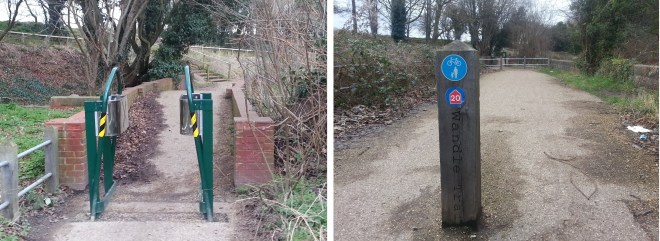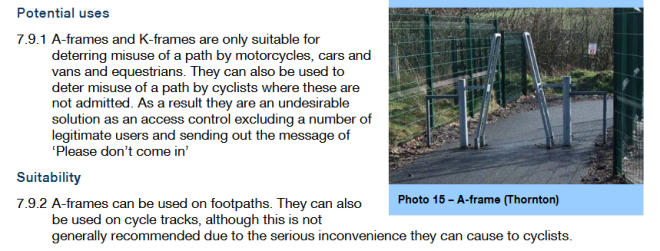Sutton Borough Council has admitted that it ignored its own cycling and transport strategies, the Equality Act, and cycling design standards when it installed a K-frame barrier on a national cycle route.
In March 2018, Sutton Council installed a K-frame anti-moped barrier on National Cycle Route 20 at Watermeads Way on the River Wandle. The barrier effectively bars anyone using a non-standard bicycle with a wide handlebar or frame, unless they are fit enough to dismount and manhandle the bike through the barrier. This is not true for some mobility-impaired people who use non-standard bikes as mobility aids. It also hinders e.g. parents using cargo-bikes to transport young children.
I wrote a separate post back in March with pictures, maps, references to the cycling design standards and immediate reactions from various stakeholders. The standards explicitly state that K-frame and similar barriers should not be installed on cycle routes due to the impact they have on anyone using non-standard bicycles.
In March, I submitted a Freedom of Information Request to Sutton Council asking how it had satisfied the requirements of the Equality Act and complied with cycling design standards. After a reminder from the Information Commissioners Office that it should reply to the request, Sutton Council belatedly provided some answers.
Question 1. Please provide the council’s policy on enabling active travel by disabled people. Please highlight the council’s duties regarding disabled peoples’ access to the cycle paths under its management.
Sutton Council:
- Objective 5 of Sutton’s Cycle Strategy extract – Ensure the borough’s cycle network is accessible to all types of bikes and cyclists, including those with disabilities and users of mobility scooters, and is designed to avoid conflict with those with visual or physical impairments.
- Objective 3 of Sustainable Transport Strategy extract. Wherever possible, cycle routes segregated from motor traffic will be implemented, either alongside roads or through parks and open spaces. In parks, use will be made of existing paths, with the preference being for segregated paths where flows of pedestrians and cyclists are high, or shared paths where flows are low. On-road provision for cyclists will also be made where appropriate. All major highway and traffic schemes will have a cycle audit to ensure that they make good quality provision for cycling. Cycle facilities should be designed to be accessible to all types of bicycle including those used by disabled cyclists.
Comment: Two good objectives in the council’s cycling and transport strategies, both recognising that the borough’s cycle routes should be suitable for “all types of bikes and cyclists … including disabled cyclists”. Alas …
Question 2. Please provide an assessment by e.g. council’s equality officer, regarding the installation of this barrier and whether the council has complied with its duties under the Equality Act 2010 regarding the ability of disabled people, and those with impaired mobility, to travel along and cycle safely on the Wandle Trail.
Sutton Council:
- The barrier was requested in response to safety concerns from local residents, and anti-social behaviour being experienced with motorcycles and scooters using the footpath.
- A site meeting was held with the local councillor, Localities Lead Officer, Highways and Neighbourhood Services to consider solutions.
- An equality assessment was not carried out as part of this but the council were mindful when installing the barrier of the need to maintain access for different users. The barrier installed is designed in such a way as to accommodate double width buggies, mobility scooters and cyclists. The width of the barrier at the top can be adjusted to accommodate these groups whilst still inhibiting mopeds.
Comment:
- Sutton Council did not undertake an equality assessment prior to installing the barrier, and has not prepared an assessment since.
- “using the footpath” … no, it’s a shared-use path designated as a National Cycle Route.
- The comment that “the barrier at the top can be adjusted” is misleading. It cannot be adjusted by a passing user. The council asked the installers to return at the end of March 2018 to widen the K-frame barrier by 5cm to its maximum width of 66cm. The barrier cannot be widened any further, short of dismantling it entirely.
- Flat handlebars, used on upright bicycles (hybrid, mountain, tricycles, cargos etc.) typically are 70 to 80cm. Therefore, everyone riding such bikes need to stop, twist the bars and manhandle their bike through the barrier. The council assumes anyone using a non-standard bicycle such as a tricycle can lift and shift a bike weighing upwards of 25kg.
- Obviously, there is no way that a side-by-side tri or quad-cycle will get through this barrier.
- So, the two objectives in the borough’s cycling and transport strategies, that the borough’s cycle routes should be suitable for “all types of bikes and cyclists … including disabled cyclists”, have been failed.
Question 3. Please list the design guidance used by council officers to build and maintain the borough’s cycle network, such as Tfl’s London Cycle Design Standards, Highways England IAN195 etc.
Sutton Council: TfL London Cycle Design Standards. On this National Cycle Network route we also considered Sustrans guidance and Wandle Valley Regional Park guidance. The path was part of a Big Green Fund project in 2013 of which one of the outcomes was more accessibility for all.
Comment:
- As noted in the March blogpost, Chapter 4 of the London Cycling Design Guide (LCDS) is explicit that K-frame barrier should not be used on cycle routes “except as a last resort … after applying other measures”. Similarly, the Sustrans guidance is explicit too, and also notes the Equality Act issues. Sutton Council has ignored the design guidance.
- In March 2015, Councillor Neil Garratt (who represented Beddington South ward for the Conservatives until May 2018) asked for the borough’s Cycling Strategy to comply with the London Cycling Design Standards. The chair of the Environment & Neighbourhood Committee, Jill Whitehead, made that commitment. That commitment has been broken.
- If a desired outcome of the Big Green Fund Project in 2013 was “more accessibility”, then installing this barrier is a backward step.
Question 4. Please explain how the installation of this barrier complies with that design guidance.
Sutton Council: An assessment of the installation against the listed guides was not undertaken as part of the process.
Comment: No shit, Sherlock.
Question 5. Please list the other measures implemented by the council to prevent access to the Wandle Trail from Watermead Lane by people riding moped and motorcycles, and the dates when those measures were tested. In other words, please demonstrate that the installation of a K-frame barrier is the “last resort” required under TfL’s LCDS Chapter 4.
Sutton Council:
- Prior to 2013 there was a kissing gate in place that did restrict the use of the path. The National Cycle Network was on a different route, via Peterborough Road.
Comment: The council, with the help of local police, did not attempt any other measures to control users of mopeds and motorcycles. The council has failed to maintain the cycle route against LCDS Chapter 4, despite its commitment to do so.
Question 6. Please provide any correspondence with the charity managing the national cycle network, Sustrans, regarding this barrier prior to its installation.
Sutton Council:
- The barrier was requested in response to safety concerns from local residents, and anti-social behaviour being experienced with motorcycles and scooters using the footpath.
- A site meeting was held with the local councillor, Localities Lead Officer, Highways and Neighbourhood Services to consider solutions. Sustrans were not included in this, and the council did not engage with them prior to its installation, but have continued to since given the concerns raised about access.
Comment:
- The answer is interesting as it indicates this was cross-departmental decision involving a local councillor, and the Neighbourhood Services and Highways teams. This cross-departmental team went to the site, looked at signs for the National Cycle Route 20 and the shared-use walking & cycling path, and decided to install a barrier.
- The local councillor is unnamed. Prior to the May 2018 local elections, the councillors were Hanna Zuchowska, Jason Reynolds and Margaret Court. (Ms Court stood down at the election, and Mr Reynolds was not elected when he stood as a candidate in a different ward.) In May, Ms Zuchowska, Ben Andrew and Vincent Galligan were elected as ward councillors, all from the Liberal Democrat Party which controls Sutton Council. Ms Zuchowska is a member of the council’s Equality and Diversity Forum (as she was before the election). Ms Zuchowska and her fellow ward councillors have declined to offer any comment on their decision to install this barrier.
- The Highways team is a joint venture with Kingston Borough Council. Alongside Waltham Forest and Enfield, Kingston is one of three London boroughs implementing mini-holland cycling programmes. If you thought a highways team involved in Kingston’s Go-Cycle programme would be cognisant of cycling design standards, then you’re wrong.
- The London Sustrans team confirmed separately to me that they were not informed nor consulted before the barrier was installed on National Cycle Route 20. I will leave the Sustrans staff to state their own views separately but I am aware they are not happy and are talking to Sutton Council.
Question 7. Please provide any correspondence between the council and cycling and disability advocacy groups, such as the Sutton group of the London Cycling Campaign, and the Wheels for Wellbeing organisation, regarding this barrier prior to its installation.
Sutton Council:
- An assessment has not been carried out. When installing the barrier we were mindful of the need to maintain access for different users. The barrier installed has therefore been designed to accommodate double width buggies, mobility scooters and cyclists. The width of the barrier at the top can be adjusted to accommodate these groups whilst still inhibiting mopeds.
Comment: See previous comments. Sutton Council, led by a local councillor and council officers installed a K-frame barrier on a national cycle route and failed to engage with any cycling or disability-related stakeholder prior to its installation.
Alongside Sustrans, I am aware the Sutton branch of the London Cycling Campaign and the disability-cycling advocates Wheels-for-Wellbeing have expressed their displeasure to Sutton Council.
Question 8. Please cite the source of the budget used to plan, acquire and install this barrier. Was it funded using Local Implementation Plan funds from Transport for London and, if so, from which line item?
Sutton Council:
- The barrier was funded through the Public Realm capital, under delegated authority, through the St Helier, The Wrythe and Wandle Valley Local Committee, on 1st November 2017. Record of the decision is here.
Comment: The decision to purchase and install the barrier was in two steps. The Wandle Valley ward committee (made up of Cllr Zuchowska and her fellow councillors) made the decision, and the purchasing decision valued at £2,684 was signed off by a council officer in the Neighbourhood team.
Conclusion
The answers to the FOI request confirmed what I suspected: the council’s councillors and officers are aware of its strategies, relevant standards and Equality Act duties, and was happy to ignore them.
I recognise the problems caused by people riding mopeds and motorcycles on cycle paths, footpaths and, in this case, river side paths. But as a society we don’t fix these issues by penalising the innocent and vulnerable and hindering their ability to enjoy safe, segregated transport options.
Councils of every political colour make clumsy decisions. But the Liberal Democrats claim that they are different to Conservatives and Labour, and are better advocates for both active-travel and disability issues.
The saga of this K-frame barrier shows that Sutton Liberal Democrats’ claims to care are worthless.
Updated 27 June to note that former Wandle Ward councillor Jason Reynolds did not stand down at the May 2018 election. He sought election in the nearby Carshalton South Ward but was not elected.











